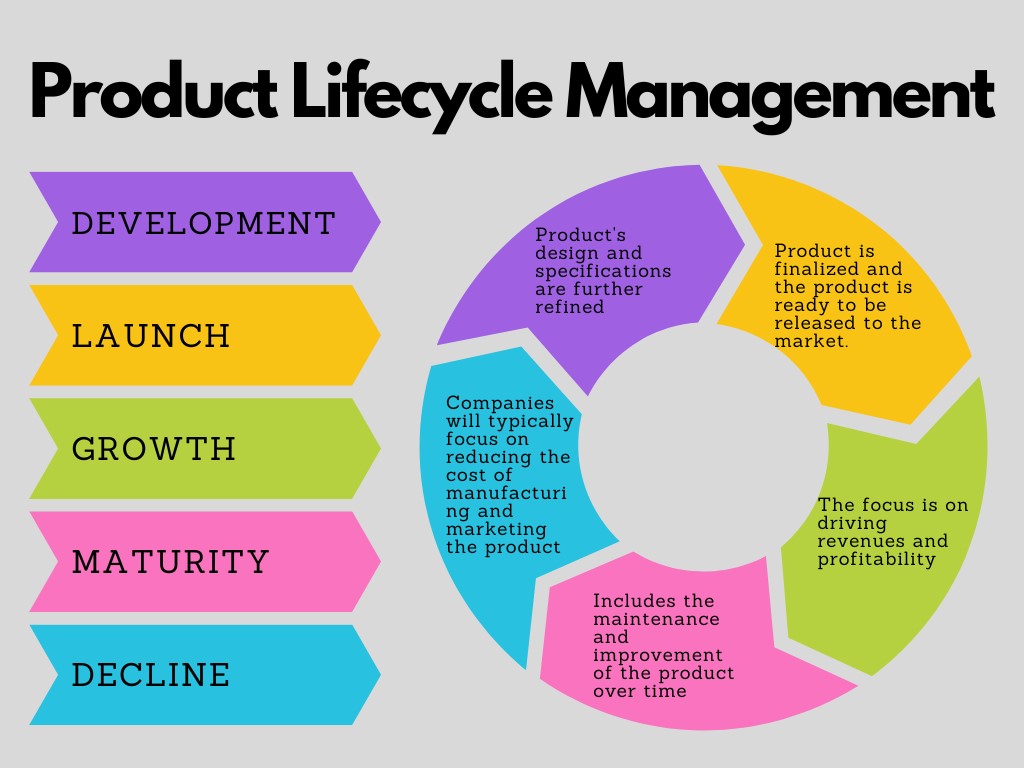Product Lifecycle Management (PLM) is a strategic approach designed to manage the entire lifecycle of a product from inception, through engineering design and manufacture, to service and disposal. It integrates people, data, processes, and business systems to provide a central information backbone for companies and their extended enterprise.
The primary purpose of PLM is to eliminate waste and improve efficiency. This is done by having a single repository for all information that influences a product. It allows companies to manage this information throughout the entire lifecycle of a product efficiently and cost-effectively. Moreover, PLM facilitates the collaboration among various departments, helping them to work cohesively. This enhances the ability to produce high-quality products that meet customer needs and compliance requirements.
Furthermore, PLM systems help organizations to maintain consistency. It does this by ensuring that all stakeholders have access to the most up-to-date and accurate product information. It supports a variety of business processes, including product development, manufacturing, marketing, and product support services. This ensures that every phase from product concept to service is executed uniformly.
Integrating PLM with other business systems like Enterprise Resource Planning (ERP), Supply Chain Management (SCM), and Customer Relationship Management (CRM) can further enhance operational efficiencies. This integration ensures that product data and processes support company-wide systems and strategies. It also provides a comprehensive view of product development processes and commercial operations.
Effective Product Lifecycle Management can transform the way products are designed, manufactured, and supported. This aligns all facets of the organization towards achieving business success and sustainability. By effectively implementing PLM, companies can ensure better product quality, faster time-to-market, and lower costs, driving significant improvements in business performance.
Key Components of Product Lifecycle Management
The core components of Product Lifecycle Management (PLM) are fundamental to its effectiveness in streamlining product development and lifecycle processes. These components ensure that all aspects of product management are cohesive and compliant with company and regulatory standards.
Product Data Management (PDM) is the backbone of PLM, centralizing all product-related information which includes designs, specifications, and documentation. This centralization ensures that everyone involved in the product’s lifecycle has access to the most current and accurate data. This reduces errors and eliminating redundancy. Furthermore, PDM facilitates a smoother transition between different stages of product development, from design to manufacturing.
Product and Portfolio Management involves strategic oversight over the entire range of products. This includes individual items to complex product lines and portfolios. This component helps companies prioritize and allocate resources effectively, making decisions that align with business goals and market demands. It also enables the tracking of product performance in the market. This helps in the decision-making process for future developments or enhancements.
Collaboration is another critical aspect of PLM. It enhances communication and cooperation across various departments and external partners. Effective collaboration tools integrated into PLM systems support real-time updates and feedback. This ensures that all stakeholders can work together efficiently regardless of their physical location. This is particularly crucial in a globalized market where teams often operate across different countries and time zones.
Compliance Management ensures that all products meet the necessary industry standards and regulations throughout their lifecycle. This component of PLM helps companies navigate the complex landscape of compliance. It does this by maintaining up-to-date records of regulations and standards, conducting regular audits. It also ensures that all products adhere to relevant laws and guidelines.
Benefits of Implementing Product Lifecycle Management
Implementing Product Lifecycle Management (PLM) offers a multitude of benefits. These benefits can significantly enhance a company’s operational efficiency and market competitiveness. One of the primary advantages is improved product quality. PLM provides a comprehensive framework for managing all aspects of a product’s development. This includes initial design through to manufacturing. This integrated approach ensures that each phase is closely monitored and controlled, reducing errors and enhancing the overall quality of the final product.
Another significant benefit of PLM is faster time-to-market. By streamlining all stages of product development, PLM facilitates quicker transitions from design to production. It enables teams to collaborate more effectively and make decisions faster, reducing delays and accelerating product launches. This rapid market entry can be a critical advantage in industries where trends and consumer preferences evolve quickly.
Cost reduction is also a key outcome of implementing PLM. By improving process efficiencies and reducing waste, companies can lower production costs. PLM helps in identifying potential issues early in the design process, which minimizes costly late-stage corrections and reduces the need for expensive recalls. Additionally, PLM systems can optimize the use of resources, including materials and labor, further driving down costs.
Enhanced collaboration across departments is another crucial advantage. PLM systems foster a collaborative environment by providing all stakeholders with access to up-to-date product information and development tools. This inclusive approach improves communication between different teams, such as design, engineering, manufacturing, and marketing, ensuring that everyone is aligned with the project objectives and timelines.
Overall, the implementation of Product Lifecycle Management can transform the way products are developed and managed, resulting in higher quality products, faster market presence, reduced costs, and improved internal cooperation. These benefits collectively contribute to a stronger, more agile business capable of thriving in competitive markets.
Challenges in Product Lifecycle Management Implementation
Implementing Product Lifecycle Management (PLM) systems can revolutionize a company’s product development processes, but it also presents several challenges. One of the most significant hurdles is the integration with existing systems. Many organizations operate on a complex mix of legacy systems and modern technologies, and ensuring that PLM software seamlessly interfaces with these can be a daunting task. Effective integration is crucial for the smooth transfer of data and maintenance of functionality across different platforms.
Change management is another critical challenge during PLM implementation. Transitioning to a new system affects not just the technological infrastructure but also the organization’s culture and workflows. Resistance from employees, accustomed to the old ways of working, can hinder the adoption of new practices. Managing this change requires clear communication, adequate training, and ongoing support to ensure all stakeholders understand the benefits and can navigate the new system effectively.
User adoption follows closely as a challenge linked to change management. Everyone involved in the product lifecycle must use the PLM system consistently and correctly for it to be effective. Encouraging users to embrace new software involves demonstrating its relevance to their specific roles and showing how it makes their work easier or more effective. Training programs and user-friendly interfaces play a significant role in enhancing user adoption rates.
Moreover, the technical complexity of PLM systems can also pose a challenge. Designing a system that accommodates all the nuances of an organization’s product development process requires detailed planning and customization. This often involves significant time and financial investment and requires expertise that may not be readily available within the company.
Future Trends in PLM
The landscape of Product Lifecycle Management (PLM) is rapidly evolving, driven by advancements in technology and shifts in manufacturing practices. One of the most significant emerging trends is the integration of Artificial Intelligence (AI) into PLM systems. AI can analyze large volumes of data from various stages of the product lifecycle, providing insights that were previously unattainable. This enables more informed decision-making, predictive maintenance, and can significantly accelerate design processes by automating routine tasks and offering design suggestions.
Additionally, the Internet of Things (IoT) is transforming PLM by connecting physical products with digital networks. IoT devices can feed real-time data back into PLM systems, tracking product performance in the field and providing valuable feedback for future design improvements. This continuous loop of feedback enhances product reliability and customer satisfaction by allowing manufacturers to respond quickly to any issues and adapt their designs to real-world use.
Advanced analytics is another area enhancing PLM systems, enabling deeper analysis of product data. These analytics can predict outcomes, optimize processes, and personalize product offerings at a granular level. By leveraging data throughout the product’s lifecycle, companies can uncover patterns and insights that lead to more innovative and responsive product strategies.
Moreover, PLM is also beginning to incorporate augmented reality (AR) and virtual reality (VR) technologies. These tools improve the design and prototyping phases by allowing designers and engineers to interact with 3D models in real-time, enhancing collaboration and reducing the time and costs associated with physical prototypes.
These trends point to a future where PLM solutions are more integrated, intelligent, and capable of driving significant improvements in operational efficiency and product innovation. As these technologies continue to develop, they will create new possibilities for managing product lifecycles more effectively, ensuring that PLM remains at the forefront of manufacturing and design innovation.
Conclusion
In conclusion, the strategic integration of Product Lifecycle Management (PLM) within an organization offers a comprehensive approach to managing every stage of a product’s life, from inception to disposal. While the implementation of PLM systems can present challenges, such as integration difficulties, change management, and user adoption, the potential benefits significantly outweigh these obstacles. Improved product quality, faster time-to-market, cost reduction, and enhanced collaboration across departments are just a few of the advantages that PLM can deliver. Furthermore, with emerging trends and technologies like artificial intelligence, the Internet of Things, and advanced analytics, PLM is set to become even more robust and efficient. These innovations promise to elevate the capabilities of PLM systems, making them indispensable tools for modern businesses aiming to succeed in a competitive marketplace.



